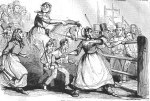Martin Fone's Blog, page 317
October 10, 2016
On My Doorstep – Part Eleven
Cows, bombs and bombers
Most of us have been fortunate enough not to have to endure aerial bombing raids so can only imagine what one would have been like to experience at first hand. Some of our older relatives had tales to tell of bomb damage – my mother was bombed out twice, once when she was living in industrial Lancashire and once when she had been evacuated to the alleged safe haven that was Paignton in Devon – and of the sensations of fear and apprehension when the air raid sirens went off.
During the course of the war Frimley Green had to endure 344 air raid warnings, the first at 8.35 in the morning on 5th September 1939. Some were fairly short in duration whilst others would last between 10 and 12 hours. At the height of the bombing raids Frimley Green was subjected to warnings on thirty-one successive days.
On Halloween, 31st October 1943, two 500 lb bombs were dropped on the village at around 10.47 in the evening, one landing behind the shops and fire station at Wharf Road and the other behind Tipper’s garage. In all 123 houses were damaged by the blasts and over 500 windows shattered, although no one was killed or injured. The bomber then proceeded towards Camberley where it was hit by anti-aircraft fire. Struggling to control his plane the pilot turned back towards Frimley Green and crash landed in the grounds of Little Ingestre at the intersection of Wharf and St Catherine’s Road, land now occupied by care homes.
Two parachutes were found, one in some bushes and the other hanging in a tree. Apart from a wallet containing Dutch currency, some scraps of German uniform and two small fragments of flesh and bone, there was nothing left of the occupants. Of particular note was the identity of the plane. It was a Messerschmitt ME 410, the first one to be shot down in England.
On August 3rd 1940 the first bombs fell on Frimley Green, mainly targeting the Basingstoke canal and the common, although one falling at Cuffley’s Farm killed a cow. It was no fun being a cow in the area. Another cow was killed and two were so severely injured that they had to be put down when a 250 kilogram bomb was dropped at 15.05 on the afternoon of August 24th 1942 about 50 yards behind Grove Farm. It left a crater 24 feet wide and 6 feet deep which became a bit of a local attraction; as a fund raising exercise the enterprising Red Cross charged a fee to view it.
The doodlebug, the missile so called because it made a strange, intermittent buzzing noise but more ominously had a device that counted the revolutions of a tiny propeller in its nose and when it reached the number calculated to bring it over its target the engine cut out, also made frequent appearances in the area. Mostly, though, the residents heard the buzz and not the pre-detonation silence. The only one I can definitively find that landed in the area did so in the Grove, about 300 hundred yards from the Cottage Hospital in July 1944, leaving a crater and providing children with the opportunity to collect shrapnel from the cornfields, now occupied by the Grove Primary School. The force of the explosion brought down the ceiling plaster in the hospital.
Filed under: Culture, History Tagged: Basingstoke Canal, bomber crash lands in Frimley Green, doodlebug hits the Grove, first ME 410 to be shot down in England, Frimley Green and air raids, Little Ingestre








October 9, 2016
Toilet Of The Week (7)
This week’s featured carsey is to be found in the Shiyan Lake Ecology Park in China’s Hunan Province. The newly opened toilets, I learned this week, offer spectacular views of the forest and the lake so that even when you have to answer your personal call of nature you can continue to enjoy the scenery.
Such convenience comes at a cost, though. The walls, ceiling and floor of the cubicles are made of glass and so you can be seen going about your business, although the area between the floor and just above the toilet seat is fitted with slightly frosted glass to preserve modesty.
I understand that since they were opened in time for the Chinese National Day’s holiday they have attracted lots of interest but few punters have been brave enough to use them, citing concerns about privacy. There’s always a spot behind the trees, I suppose.
Filed under: Humour, News Tagged: all glass loos opened in Chinese Nature Park, Hunan Province, Shiyan Lake Ecology Park








October 8, 2016
Rule Of The Week
The Great British public was shocked when an arcane rule was triggered last Sunday. No, I’m not talking about Theresa May’s announcement that Article 50 will be triggered by the end of March 2017 but something more important to the welfare of the nation, Strictly Come Dancing.
Anastacia reportedly tore some internal scars from her double mastectomy operation which meant that she was unable to take part in the elimination dance off with Kiss FM DJ, Melvin Odoom (me neither). Rather than giving the injured celeb the order of the boot, the Beeb revealed a house rule that said in such circumstances the participant with the lowest public vote would be shown the door.
So Melvin’s hopes of glitterball glory were o’doomed, the 11th male to exit in the first round in 14 series, and Anastacia lives to fight another day. Can’t think these shenanigans have helped her popularity ratings. An early exit is on the cards, methinks.
Filed under: Humour, News Tagged: Anastacia, House rule allows injured star to progress in Strictly, Melvin Odoom, Strictly Come Dancing








October 7, 2016
What Is The Origin Of (100)?…
Curry favour
I have spent most of my life trying to avoid the accusation that I was currying favour. When we use the phrase we mean that the person is trying to keep on the good side of someone else, often by carrying out acts to keep in favour. When you stop and think about it, it seems a very odd phrase, particularly as we nowadays associate the word curry as a noun with a spicy dish from the Indian subcontinent and as a verb with the act of spicing up a dish. But our phrase has nothing to do with the dish.
Rather from the late 13th century curry was used in the context of grooming a horse, owing its origin to the Anglo-French curreir, meaning to curry comb a horse and which in turn came from the Old French, correier, meaning to put in order, prepare, curry. Having sorted that out, it won’t surprise you that favour is a form of horse, although how it got there is rather convoluted.
Although English is a fascinating amalgam of words and roots from disparate sources, one of our endearing characteristics is our inability to get our tongues around words of foreign origin. Our particular deafness to phrases from other lands leads to an amazing number of mash-ups. Favour in our phrase is a mishearing or misspelling of fauvel.
In 1310 Gervais du Bus wrote a satirical poem entitled Roman de Fauvel, in which Fauvel, a vain and ambitious horse, deceives and corrupts the greedy French courtiers and churchmen. They humiliate themselves by bowing down and stroking the coat of their false leader. In other words, they are currying (combing) Fauvel. Fauvel or its variant favvel is an acrostic made up of the first letters of the seven deadly sins – flaterie, avarice, vilanie (wrath), variete (inconstancy), envie and lachete (cowardice). Favel is also used to denote the colour fallow, a sort of pale brown, which in mediaeval times in association with a horse or donkey was a symbol of duplicity, greed or deceit.
In 1530 in his Lesclarcissement de la lange Francoyse, John Palsgrave defined curryfavell as a flatterer. Notwithstanding that, there is evidence that favell had been converted to favour by 1510. Alexander Barclay wrote in his The mirrour of good manners, “flatter not as do some, with none curry fauour”. An annotation to translation of the New Testament of 1557 records that the intent of Matthew 8 verse 20 was “by this means to courry fauour with the worlde.” It is tempting to think that favour and favell coexisted happily aside each other until at some point du Bus’ poem was forgotten, people puzzled what fauvel was all about and quietly dropped it.
Not unsurprisingly, given fact that the Orient was pretty unknown territory to the insular English until the 16th century, the noun curry which comes from the Tamil kari meaning sauce or relish for rice did not come into circulation until then. The first instance of its usage in print appears to be in a translation of Van Linschoten’s His Discours of Voyages into ye Easte and West Indies of 1598, “which they seeth in broth, which they put upon the rice, and is somewhat soure..but it tasteth well and is called Carriel”.
So now we know!
Filed under: Culture, History Tagged: curryfavell, Gaston du Bus, John Palsgrave, kari, meaning of acrostic favvel, origin of curry, origin of curry favour, Roman de fauvel








October 6, 2016
There Ain’t ‘Alf Some Clever Bastards – Part Sixty
Edwin Howard Armstrong (1890 – 1954)
Before the arrival of Digital Audio Broadcasting (DAB) what revolutionised the quality of radio signals was the switch to Frequency Modulation (FM) from Amplitude Modulation (AM). Gone for the most part were those irritating hisses from extraneous noises which affected and spoiled an AM radio programme. The battle to get FM adopted was long and hard and eventually did for its inventor, the latest inductee to our Hall of Fame, Edwin Armstrong.
In the mid 1920s Armstrong began researching into ways to eliminate the static that bedevilled AM radio, initially by modifying the characteristics of existing AM transmissions with little success, before in 1928 turning to investigate the use of frequency modulation transmissions. Working away in a laboratory in Columbia’s Philosophy Hall, he developed what is now known as wide-band FM which had significant advantages over the previously developed narrow-band transmissions. He was granted five US patents on 26th December 1933 on the basic features of his new system. That was the easy part.
Armstrong had a standing arrangement with RCA to give them first refusal on his patents and whilst they were impressed, were investing in the nascent television technology and so declined the opportunity. Undaunted he decided to finance his own development and form ties with smaller players in the radio industry like Zenith and General Electric. In June 1936 Armstrong demonstrated his new system to the US Federal Communications Commission (FCC) in front of an audience of 500 engineers, by playing a jazz record through conventional AM radio frequencies and then through FM. A contemporary noted “if the audience..had shut their eyes they would have believed the jazz band was in the same room. There were no extraneous sounds”.
But, as you would expect with an inductee, Armstrong hit major problems. Firstly, a switch-over to the ultra-high frequency system would mean scrapping all the existing broadcasting equipment and domestic radios, an expense which for America just emerging from the Great Depression was unpalatable. Then when interest in FM grew amongst some of the radio stations, construction restrictions that were put in place during the Second World War limited its growth. And then to prevent interference between radio stations that were early adopters of FM and the mainstream AM stations the FCC reallocated the FM band – to 88 to 108 Mhz – which meant that the FM equipment and receivers had to be scrapped. Armstrong saw the dead hand of RCA behind the attempts to frustrate the adoption of FM.
Armstrong’s fourth problem was his battle with RCA. In 1940 they had offered him $1 million for a non-exclusive, royaIty-free licence to use his FM patents but Armstrong turned them down. This prompted RCA to conduct their own research into FM and develop what they claimed to be a system which didn’t infringe Armstrong’s patents. Worse still, RCA encouraged other companies to stop paying royalties to Armstrong. In 1948, our hero sued RCA and NBC, claiming patent infringement and that they “had deliberately set out to oppose and impair the value” of his invention.
The case dragged on depleting Armstrong’s finances, worsened when his primary patents expired in late 1950. It all got too much for him and during the night of 31st January/1st February 1954 Armstrong jumped to his death from a window of his flat on the 13th floor of River House in New York City. His wife, Marion, pursued the case against RCA and reached an out of court settlement of around $1m. It was not until the 1960s that FM started to get really established in America, although NASA adopted Armstrong’s system for communications between Houston and the Apollo astronauts.
Edwin, for developing FM and not profiting from it, you are a worthy inductee into our Hall of Fame.
If you enjoyed this, why not try Fifty Clever Bastards by Martin Fone which is now available on Amazon in Kindle format and paperback. For details follow the link https://www.amazon.co.uk/s/ref=nb_sb_noss?url=search-alias%3Daps&field-keywords=fifty+clever+bastards
Filed under: Culture, History, Science Tagged: Amplitude Modulation, Armstrong's law suit with RCA, Edwin Armstrong, Federal Communications Commission, Fifty Clever Bastards, Frequency modulation, Martin Fone, the inventor of FM, the reallocation of FM wavebands








October 5, 2016
It’s Been Done Before – Part Two
Heron of Alexandria (circa 10CE to 70CE)
You are at a train station. You feel peckish but to your consternation the queue at the kiosk is too long. You spot a vending machine. You fumble in your pocket, extract a coin and put it into the slot. If you are lucky your coin is accepted, you make your selection and, hey presto, your snack pops out of a dispenser, leaving you just enough time to catch your train.
The first modern coin-operated vending machine was invented by Percival Everitt in 1883 and soon appeared on railway stations dispensing envelopes, postcards and notepaper. The first American version was built by the Thomas Adams Gum Company in 1888 and was used to dispense gum on New York railway platforms. Brass portable coin-operated machines were to be found as early as 1615 in English taverns, from which you could get your tobacco and Simeon Denham secured a patent in 1867 for his stamp machine, the first fully automatic vending machine.
But the idea of having a machine that was coin-operated goes back to the first century of the Christian Era and was the brain child of inventor and mathematician, Heron, who lived in one of the intellectual powerhouses of the Roman Empire, Alexandria. In his book Mechanics and Optics he described a coin-operated machine which dispensed a quantity of holy water. When the coin was deposited into the top of the machine, it fell on to a pan attached to a lever. The lever opened up a valve allowing the water to flow out. The pan continued to tilt until the coin fell off causing a counter-weight to snap the lever back up and turn off the valve.
The harnessing of steam power, thanks to the likes of James Watt, was a key factor that led to what we call the Industrial Revolution in Britain. But Heron had got there first too, with his aeolipile. This consisted of a sphere which either contained water that was boiled or had pipes attached to a tank underneath in which the water was boiled. Two nozzles opposite each other in the sphere would expel steam and after a while sufficient force would be generated to spin the it around its axis. A replica of his specification has been built and rotated at 1,500 rounds per minute with a very low pressure of 1.8 pounds per square inch. It was not until 1577 that Taqu al-Din picked up Heron’s mantle and developed a mechanism for rotating a spit using steam.
If you think that was enough, Heron wasn’t finished, not by a long chalk. He described a syringe-like device which could be used for the dispensing of air or liquids. He came up with possibly the first wind-operated machine, one that harnessed the wind to power an organ. And we shouldn’t forget his stand-alone fountain which used its own hydrostatic energy.
In the field of mathematics he described a method for iteratively calculating the square root of a number and developed a formula for finding the area of a triangle from the length of its sides. And in optics he formulated the principle of the shortest path of light, and idea that was not picked up and developed to include reflection and refraction for nigh on a thousand years, by Alhacan.
You cannot help wonder what the world would have been like today, had Heron’s ideas not lain on the dusty shelves of the library at Alexandria for centuries.
Filed under: History, Science Tagged: aeliopile, first wind-operated machine, Heron of Alexandria, Heron's formula, Heron's vending machine, inventor of vending machine, Percival Everitt, Simeon Denham, Taqu al-Din








October 4, 2016
I Don’t Want To Belong To Any Club That Will Accept People Like Me As A Member – Part Twenty Seven
Graham’s, St James’s Street
For the rich and indolent in late 18th and early 19th century London a game of cards and the gambling that went with it was a regular form of entertainment. One of, if not the, most famous places to play cards was to be found at an unpretentious looking house at no 87, St James’s Street, known as Graham’s Club. It took its name from the father and son duo who owned and ran the gaff. Members, it is said, devoted themselves exclusively to cards, the principal game being whist.
Whist was an offshoot of the 16th century game, trump or ruff, its name coming from the 17th century word which meant quiet, silent and attentive. It is hard to imagine the crowd at Graham’s staying quiet for long. For whist aficionados the Blue Peter is a call for trumps, a signal indicating that the player wishes their partner to lead with trumps. It was at Graham’s that Lord Henry Bentinck invented the signal.
The amounts wagered at the tables were prodigious. Contemporary reports state that “a long list would be required in which to set down the names of those of its members who retired from it broken, or who staved off the evil day by frequent applications to Messrs Howard and Gibbs, the then fashionable and much patronised money-lenders”. One player, Colonel Aubrey reportedly lost the princely sum of £35,000. He didn’t seem to mind saying that next to winning, losing was the greatest pleasure in life.
Not all the members took such a stoical attitude to the fickle finger of fate. In 1837 Lord de Ros, reputedly an excellent whist player, was privately accused of cheating, marking cards and reversing a cut when acting as a dealer. Although his conduct was considered to be “of the meanest and most degraded character”, nothing was said publicly, that is until the periodical, The Satirist, got wind of the scandal. This brought de Ros’ accusers out into the open and the Lord sued one for slander.
During the court case it emerged that there had been suspicions about the Lord for some six years – perhaps that is why he was such a successful player – and some had consciously avoided playing with him whilst others were very keen to partner him. It only took the jury 15 minutes to reach their verdict and the disgraced Lord was forced to leave with his family for foreign lands.
The potential for easy pickings attracted undesirables to the club and so serious was the problem of persuading them to sling their hook that the Club took the unusual and slightly desperate step on December 31st 1836 of dissolving itself. It then set up again, of course minus the ten or so reprobates that they had been so anxious to shed.
But even this didn’t seem to work. The renascent club never regained its former glory and struggled financially, not least because its members were reluctant to pay their subscriptions. This left the Grahams with no alternative but to fold the club, an ignominious end to the most famous whist club in the world.
Filed under: Culture, History Tagged: Blue Peter whist signal, Graham's Club in St James's Street, Lord de Ros, Lord Henry Bentinck invented blue peter signal in whist, meaning of whist, the most famous whist club in the world, trump or ruff








October 3, 2016
I Predict A Riot – Part Fourteen
The Rebecca Riots
There are relatively few roads in Blighty that you have to pay to use – our vehicle road tax eliminating the need to pay tolls. It was not ever thus. In the late 18th and early 19th centuries the state of the roads was so bad that turnpike trusts were established, usually by Act of Parliament. In return for improving the condition of the roads in their area the Trustees were able to erect toll gates and charge the users of the road a fee for the privilege.
In the rural Welsh counties of Pembrokeshire, Cardiganshire and Carmarthenshire, toll gates were erected like they were going out of fashion. The market town of Carmarthen was surrounded by twelve such gates, meaning that whichever way the local residents approached it to trade their produce and livestock, they had to pay a toll. This was particularly irksome, especially when economic conditions in the rural communities were harsh.
The flashpoint and the start of what became known as the Rebecca Riots was the erection of a new gate at Efailwen in in Carmarthenshire in 1839 to catch farmers who were evading the other toll routes. A large crowd assembled and tore down the gate. When the gate was restored by the turnpike trustees, a public meeting was held, the consensus being that there was no need for a toll gate at Efailwen and it was destroyed again.
Why Rebecca? If nothing else, the chapel-going communities of Wales knew their bible and in particular Genesis 24, verse 60, “and they blessed Rebekah, and said unto her, Thou art our sister, by thou the mother of thousands of millions and let thy seed possess the gate of those that hate them”. The trustees were generally the local gentry who were often also the landlords from whom the farmers rented their land. They were seen as oppressors because of the high rents they extracted and because of the toll charges. The toll gates, obvious symbols of oppression, if you followed this line of reasoning, became the focus of all the simmering discontent in the Welsh countryside.
The rioters wore women’s clothing and blackened their faces. The ringleaders bore the names of Rebecca, Charlotte, Nelly and Miss Cromwell whilst the foot soldiers were known as “daughters”.
The riots reached their height between 1842 and 1843 when economic conditions in the area took a further turn for the worse. So successful were the rioters that not one toll gate remained standing in the three counties. Threatening letters were sent to landlords trying to force them to lower rents and some individuals who were thought to be against the cause – “I am averse to tyranny and oppression” was their rallying call – were beaten up. The workhouse at Carmarthen was attacked and there were several incidents where shots were fired. Surprisingly, only one person, a woman, was killed in the riots.
In an attempt to restore order troops were sent but the rioters who knew the terrain better led them a merry dance spreading false rumours as to where they were going to strike next and watched qith amusement as the troops marched through the countryside to no avail. Only a change to the toll gate system and the poor laws pacified the locals but by then life in rural South West Wales had changed for ever. More and more people left the countryside to find employment in towns, the arrival of the railway into the area in the late 1840s facilitating the diaspora.
A Pyrrhic victory for the rioters, methinks.
Filed under: Culture, History Tagged: causes of rebecca riots, Efailwen toll gate, Genesis 24 verse 60, I am averse to tyranny and opression, The Rebecca Riots, toll gates, Turnpike Trusts








October 2, 2016
Pork Pie Of The Week
Brits and abroad. You can’t get a decent cup of tea and the baked beans aren’t up to much. Part of the luggage allowance of many a British holidaymaker is made up of those daily comestibles that make life bearable and Johnny Foreigner just can’t seem to get right.
But sometimes this habit leads to unanticipated problems as pensioner, Norman Pearson, discovered as he was travelling through Manchester airport en route to Malaga, I read this week. He had packed a particularly juicy pork pie in his luggage. His bag went through the scanner and triggered a security alert as it showed that it contained some form of liquid. On unpacking the bag the security staff found a pork pie with an unusually high juice content amongst his clothing.
As Pearson from Wigan, a town famous for its pie eaters, couldn’t extract the juice from the pie and put into one of those plastic bags, the staff wished him “Bon appetit” and allowed him to take the snack with him.
Forewarned is forearmed.
Filed under: Humour, News Tagged: food in your luggage, Norman Pearson, pork pie triggers security alert at Manchester airport, Wigan piee eaters








October 1, 2016
Brassica Of The Week
Regular readers will have noted I have been a bit quiet on the pumpkin front this year. It has been a disaster. The first two lots have withered and died and the third crop (a collective noun for four), in truth, look like smallish lemons and are probably too late to grow much more. Very dispiriting.
Perhaps I should switch my attention to growing red cabbages. David Thomas from Cornwall, I read this week, smashed a 91 year old world record by growing a 23.2 kilogram red cabbage which he entered into the UK’s National Giant Vegetables Championship at Malvern. The previous record was held by a Mr R Straw whose red cabbage weighed in at 19.05 kg in 1925. Mr Thomas already holds the record for the heaviest parsnip and cucumber at 7.85kg and 12.9 kg respectively.
The key to his success, Dave reveals, is having the right seeds, plenty of room, good soil and a bit of luck. Simple.
Filed under: News Tagged: Dave Thomas from Cornwall., growing pumpkins, UK’s National Giant Vegetables Championship at Malvern, world's heaviest red cabbage






















